11 Silver Leaved Perennials You Can Enjoy For Years At A Time

Reviewed By COLIN SKELLY

Colin is a Horticulturist and Horticultural Consultant with experience in a range of practical and managerial roles across heritage, commercial and public horticulture. He holds the Royal Horticultural Society’s Master of Horticulture award and has a particular interest in horticultural ecology and naturalistic planting for habitat and climate resilience.
Add some metallic zip and zing to your garden’s display with these silver-leaved specimens.
Silver foliage is a striking addition to any garden.
Not only are the colours of the leaves unusual and eye-catching in their own right – especially when reflecting the sunlight just so – but they also serve to accentuate brighter flowers in their vicinity.
Indeed, this ability to complement the surrounding specimens makes silver and grey plants a highly versatile ingredient in any outdoor display.

When selected with an artful eye and placed in juxtaposition with other colour combinations, they can really bring the whole ensemble to life.
By opting for perennials over annuals, you’ll also have the added advantage of enjoying the aesthetics of your arrangement for years at a time.
As such, any of the following suggestions would make a delightful addition to your back garden, adding some wintry whimsy to spice up its palette.
1) Artemisia schmidtiana

- RECOMMENDED VARIETY: ‘Silver Mound’
- HARDINESS RATING: H5
- FOLIAGE TYPE: SEMI-EVERGREEN
- FOLIAGE SEASONS: YEAR-ROUND
As its cultivar common name suggests, Artemisia schmidtiana forms dainty hummocks of slender silver foliage.
It grows up to 30cm in height and has a similar spread, making it great for minimalist ground cover.
Whether utilised as part of a herb garden, rock garden or standalone specimen, ‘Silver Mound’ has a cushioning appeal that softens the edges and sharpens the appeal of any background it adorns.
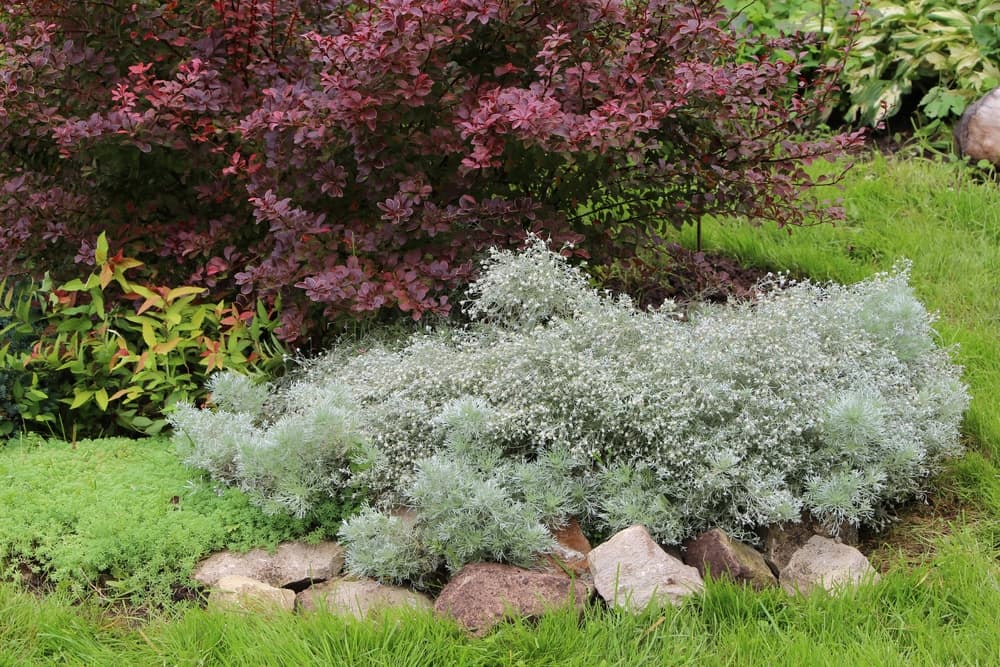
It’s semi-evergreen and will retain its foliage in warmer climes, providing great contrast to other perennials with pink, purple or red blossoms.
As for its own flowers, A. schmidtiana does produce clusters of tiny yellow blooms in summer, but they add little in the way of aesthetic value.
Instead, it’s best to prune them immediately to preserve the purity of its cool demeanour.
2) Brunnera macrophylla

- RECOMMENDED VARIETY: ‘Jack Frost’
- HARDINESS RATING: H6
- FOLIAGE TYPE: DECIDUOUS
- FOLIAGE SEASONS: SPRING / SUMMER
There are few plants more distinctive than Brunnera macrophylla when it’s in its full pomp.
Featuring oversized, heart-shaped leaves that have been unmistakably touched by the hand of ‘Jack Frost’, it’s an immediate crowd-pleaser in any environment.
The main attraction is undoubtedly the foliage, whose generous proportions and silver surface edged and veined in green are enough to set it apart from most garden varieties.
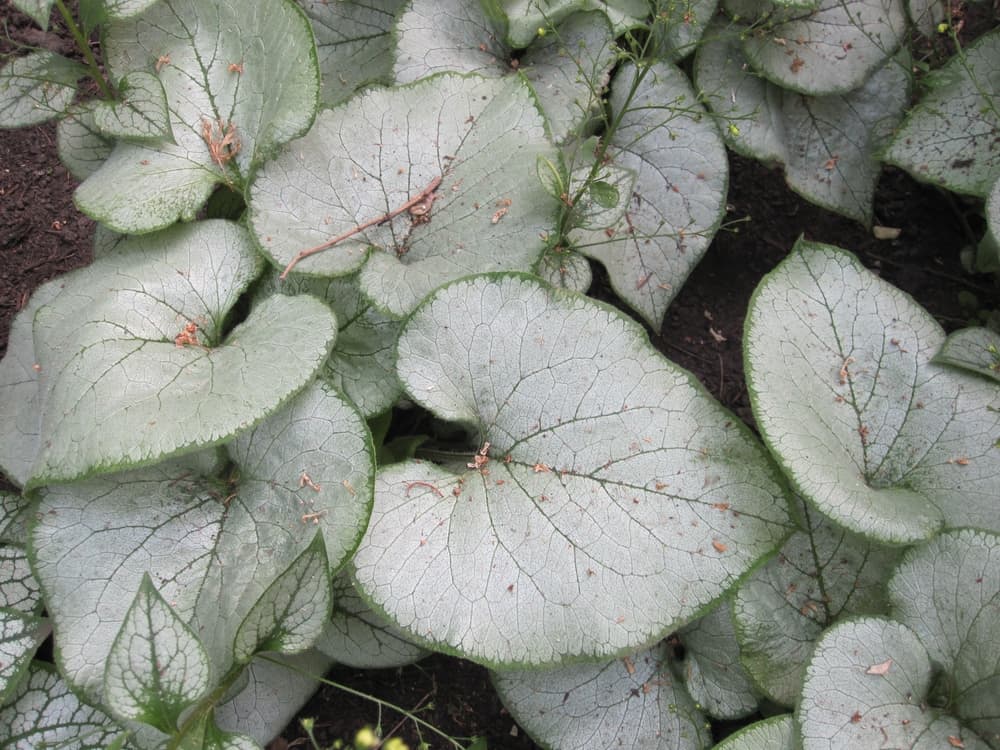
It does, however, also boast delicate blue blossoms in the springtime, which serve to emphasise its icy appeal even further.
It’s a fairly resilient plant which will grow well in most soil types and in full or partial shade, reaching up to 50cm in height at its peak potential.
“Brunnera macrophylla is a great choice for a shady spot,” says Master Horticulturist Colin Skelly.
“Known for its spring flowers, Brunnera is also a great silver-leaved plant that covers the ground vigorously whilst being an attractive ornamental choice.”
This makes it great for brightening up dim or dark corners, or else providing a pleasing contrast underneath taller and more colourful companions.
3) Caryopteris clandonensis
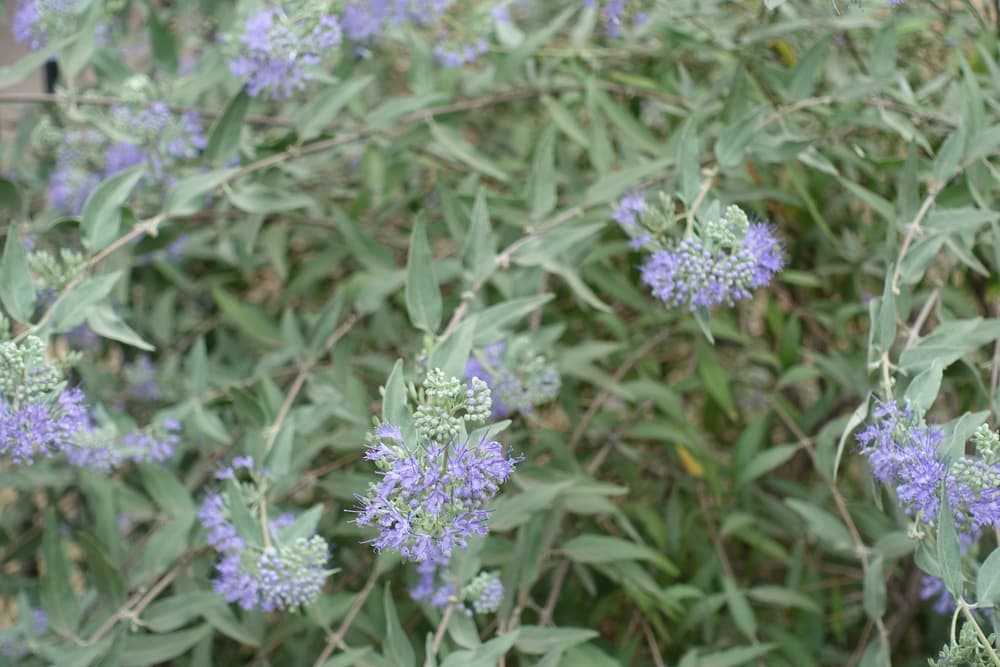
- RECOMMENDED VARIETY: ‘Sterling Silver’
- HARDINESS RATING: H4
- FOLIAGE TYPE: DECIDUOUS
- FOLIAGE SEASONS: SPRING / SUMMER / AUTUMN
The blue-green foliage of Caryopteris clandonensis, set off perfectly by its silvery tinge, makes this shrub a head-turner at any time of the year.
However, it really comes alive in late summer and early autumn, when the bright blue of its blossoms adds another dimension to its appeal.
It can grow up to 1m in height and around 1.5m in spread, making it perfect for positioning at the front of a sunny border.
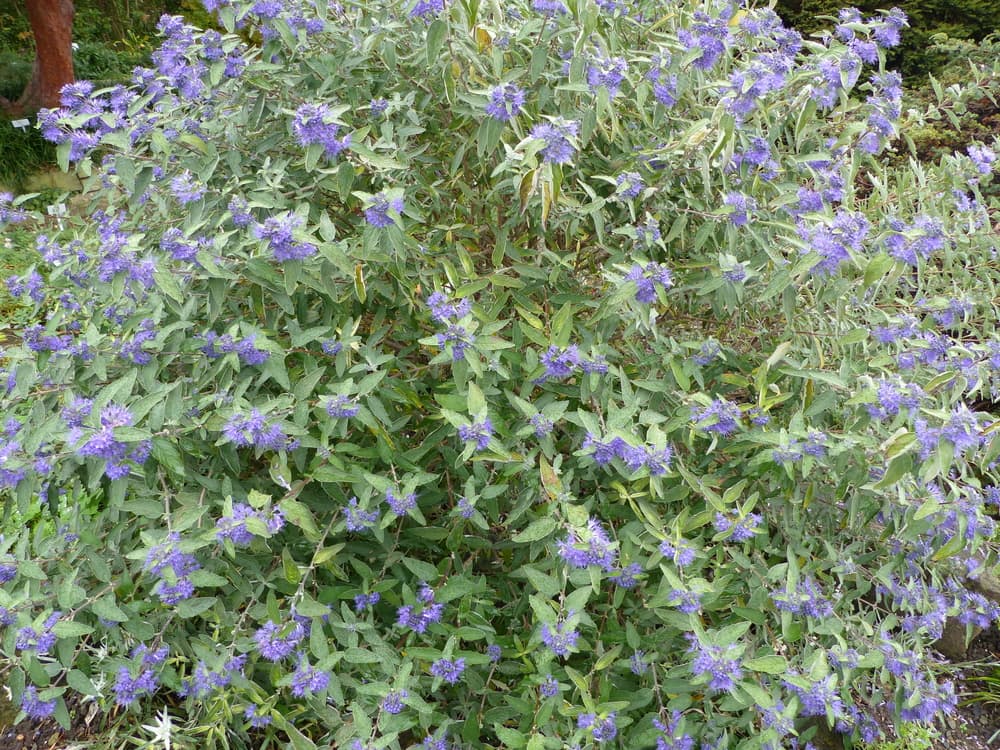
Alternatively, you could choose to play to its strengths and make a focal point of the whole plant, cultivating it in a pot or container in the centre of a patio or balcony.
It does appreciate full sun, however, so make sure it has enough access to sunlight.
For best results, prune it back ruthlessly once the blossoms have died away to ensure that they return with vigour the following year.
4) Centaurea cineraria
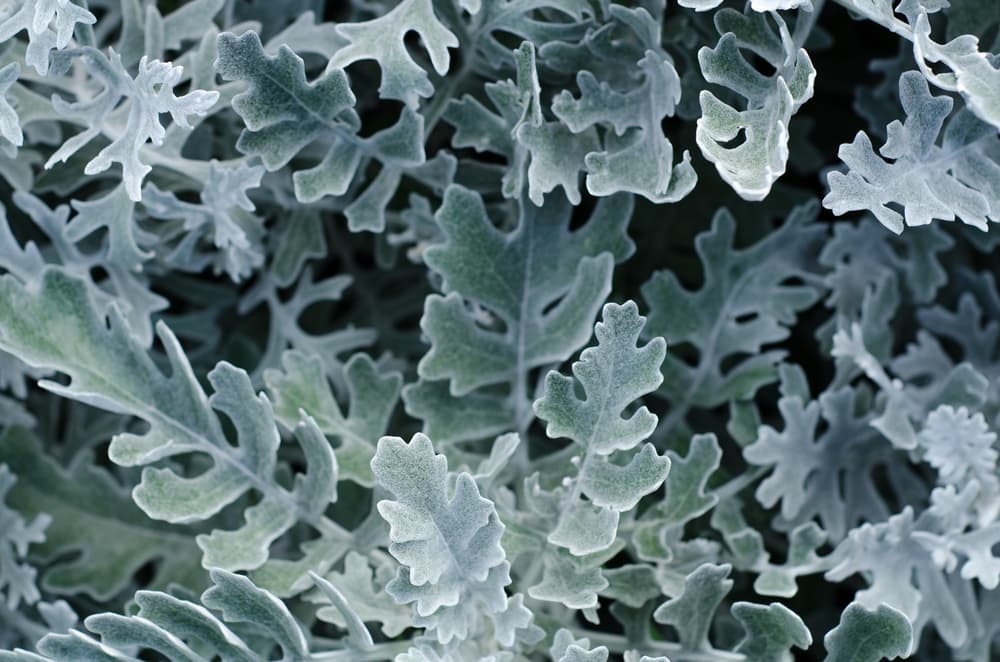
- RECOMMENDED VARIETY: ‘Dusty Miller’
- HARDINESS RATING: H3
- FOLIAGE TYPE: EVERGREEN
- FOLIAGE SEASONS: YEAR-ROUND
Depending on the time of the day and the light in the sky, Centaurea cineraria can appear blue, green or grey.
Whatever the dominant colour, this sprawling evergreen perennial is remarkable for the woollen texture of its leaves, as well as their eye-catching tints.
In summertime, the display is enhanced by the appearance of purple flowerheads that are almost reminiscent of thistles.

The bulbous form of the blooms contrasts pleasingly with the finely-divided lance shapes of the foliage, making for an attractive plant for beds, borders and gravel gardens.
It does fine in most soil types as long as they enjoy excellent drainage, though it is demanding about the amount of sun it receives.
Indeed, it can tolerate milder parts of the UK round the calendar, but those living in areas which suffer from colder winters should transplant it to a greenhouse or conservatory for the duration.
5) Cynara cardunculus
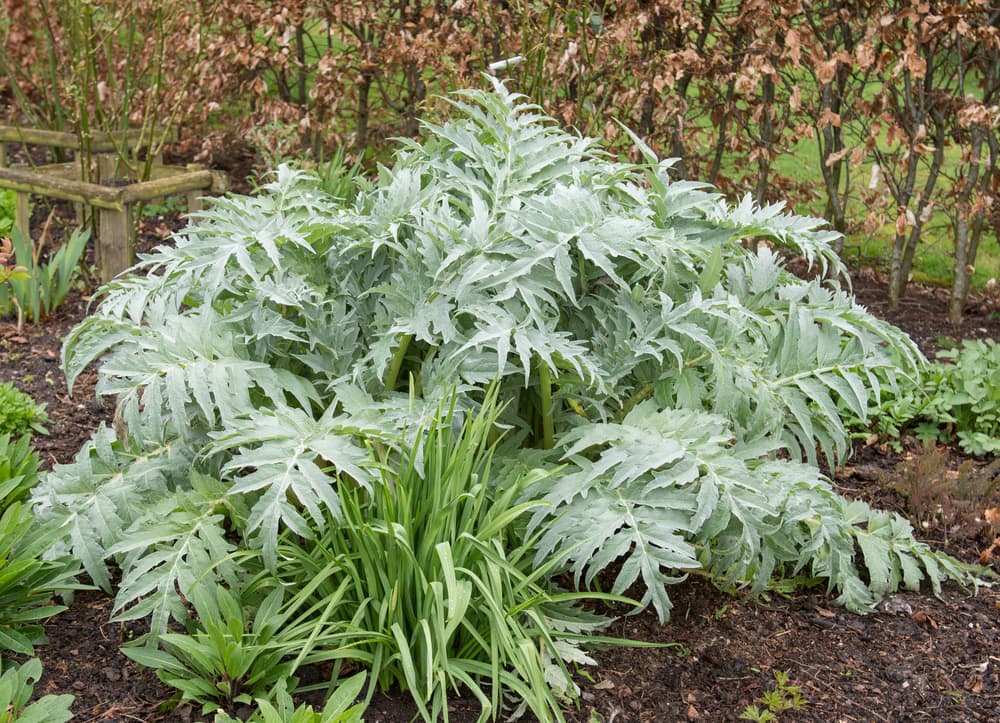
- RECOMMENDED VARIETY: ‘Cardoon’
- HARDINESS RATING: H5
- FOLIAGE TYPE: DECIDUOUS
- FOLIAGE SEASONS: SPRING / SUMMER / AUTUMN
Like Centaurea cineraria, Cynara cardunculus enjoys large, thistle-like blossoms of a bright purple in mid to late summer.
However, the leaves of the two plants are wildly different, despite sharing the same greyish hue.
Unlike its more intricate counterpart, C. cardunculus is defined by foliage which is spiny and spiky in outline and amply proportioned in size.

Even a single leaf is capable of growing up to 1m in length!
The plant as a whole, meanwhile, can reach 1.5m in height and 2.5m in spread, meaning it forms quite the focal point.
Sometimes known as “prickly artichokes” (but more commonly as “cardoons”), these robust specimens are excellent for adding architectural intrigue to wild gardens, rear borders or raised beds.
They also make attractive cut flowers, too.
6) Eryngium giganteum
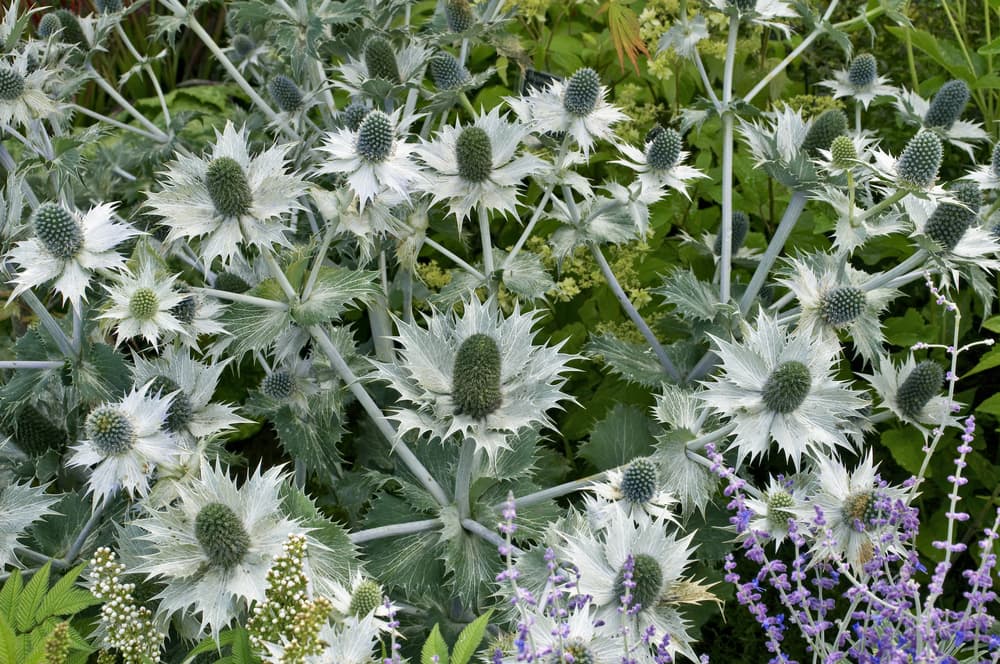
- RECOMMENDED VARIETY: ‘Silver Ghost’
- HARDINESS RATING: H6
- FOLIAGE TYPE: DECIDUOUS
- FOLIAGE SEASONS: SPRING / SUMMER / AUTUMN
Commonly known as sea holly, this striking specimen continues the theme of thistle-like flowerheads.
However, this time the blooms aren’t purple, but rather blue – and they perhaps look their best after flowering, when the dead blossoms add to the ethereal aesthetic of the plant.
As such, deadheading this ‘Silver Ghost’ might be the most preferable strategy in the long term, since it will encourage stronger growth the following year, but it does sacrifice the impressiveness of its appearance in the short term.

Given that it’s one of the shorter-lived perennials on this list, it might be best to enjoy its full glory while you can.
In any case, it will do best in dry, well-drained soils, since it’s vulnerable to root rot in waterlogged environments.
It also demands full sun in order to thrive – but it’s well worth getting the conditions right for the aesthetic impact it brings.
7) Helichrysum petiolare

- RECOMMENDED VARIETY: ‘Goring Silver’
- HARDINESS RATING: H3
- FOLIAGE TYPE: EVERGREEN
- FOLIAGE SEASONS: YEAR-ROUND
Helichrysum petiolare is colloquially known as the ‘liquorice plant’, thanks to the faintly aniseed-like fragrance which accompanies it.
But quite apart from its aromatic qualities, this trailing perennial is hugely popular for its delicately felted leaves.
The furry texture and greyish silver surface of the foliage make it a neutral accompaniment to borders and flower beds.

On the other hand, you could choose to foreground its showy qualities by placing it in a hanging basket or patio pot, where the trailing fronds of its stems will hang invitingly over the edges of its container.
Small but perfectly formed, ‘Goring Silver’ is a less vigorous or invasive grower than some of its brethren in the Helichrysum family.1Helichrysum petiolare (strawflower). (2022). CABI Compendium. https://doi.org/10.1079/cabicompendium.114715
This actually makes it far more versatile and appropriate in a wide variety of settings, offering great flexibility to gardeners.
8) Heuchera

- RECOMMENDED VARIETY: ‘CAN CAN’
- HARDINESS RATING: H6
- FOLIAGE TYPE: SEMI-EVERGREEN
- FOLIAGE SEASONS: YEAR-ROUND
The Heuchera genus is packed full of evergreen perennial options in all shapes and sizes, many of which come with a silver hue to their foliage.
‘Can-Can’ is no exception, though it does differ from many of the options on this list due to its interesting contrasts in colour.

The topsides of the leaves are the type of deep red you’ll fine in vineyards and wine cellars all over the world, with widespread silver marbling across their surface.
Meanwhile, the underside of the foliage is a much brighter purple, creating a pleasing disparity that’s highly noticeable due to the undulating structure of the leaves.
Green flowers join the party in midsummer but don’t add much more than the plant offers for the rest of the year and should be deadheaded immediately after dying – or perhaps even sooner if you prefer.
9) Lychnis coronaria
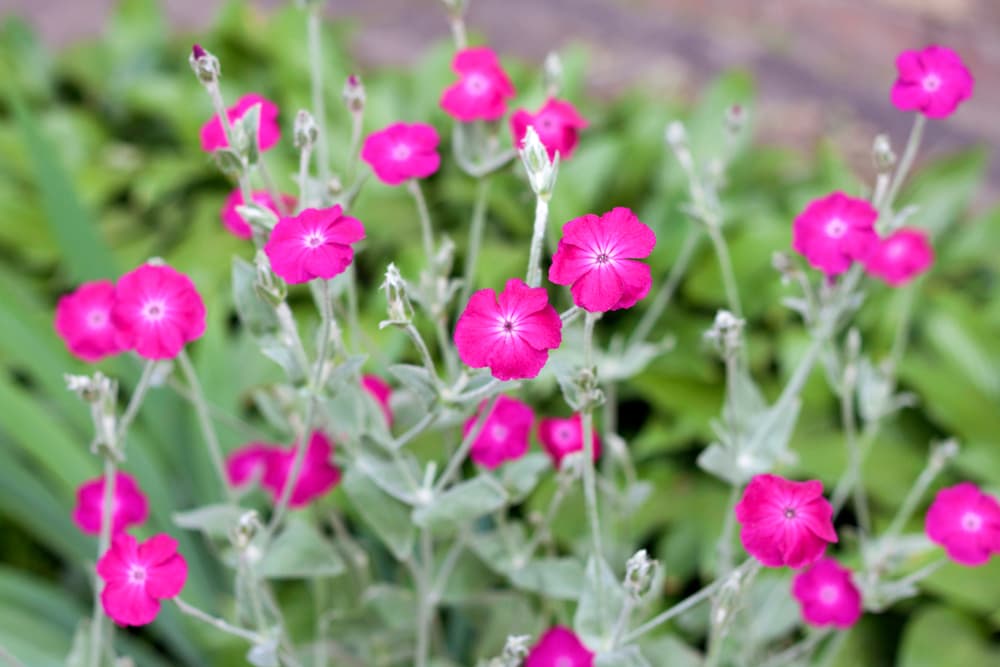
- RECOMMENDED VARIETY: ‘Rose Campion’
- HARDINESS RATING: H7
- FOLIAGE TYPE: SEMI-EVERGREEN
- FOLIAGE SEASONS: YEAR-ROUND
A short-lived perennial, Lychnis coronaria only really offers up much in the way of aesthetic appeal during the summer months.
However, its loud contrasts and pollinator-attracting qualities make it worth the effort of cultivation.
The plant features clumps of slender silvery stems, populated with furry silver leaves and set off by stunning magenta blooms in July, August and September.
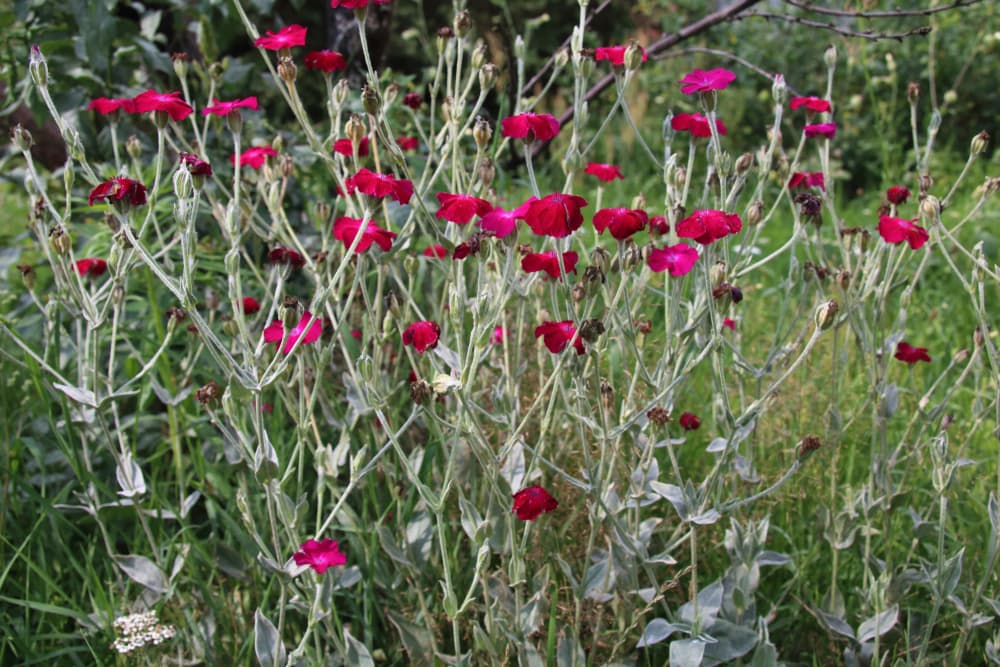
The conflict between the neutrality of the foliage and the garishness of its blooms makes for a show-stopping display, explaining why it’s popular around the country.
Although a fairly hardy customer, it appreciates dryer soil and will produce brighter colours in its blooms if obliged.
Those looking to propagate it should collect seeds in September and October, before planting them the following spring.
10) Santolina chamaecyparissus
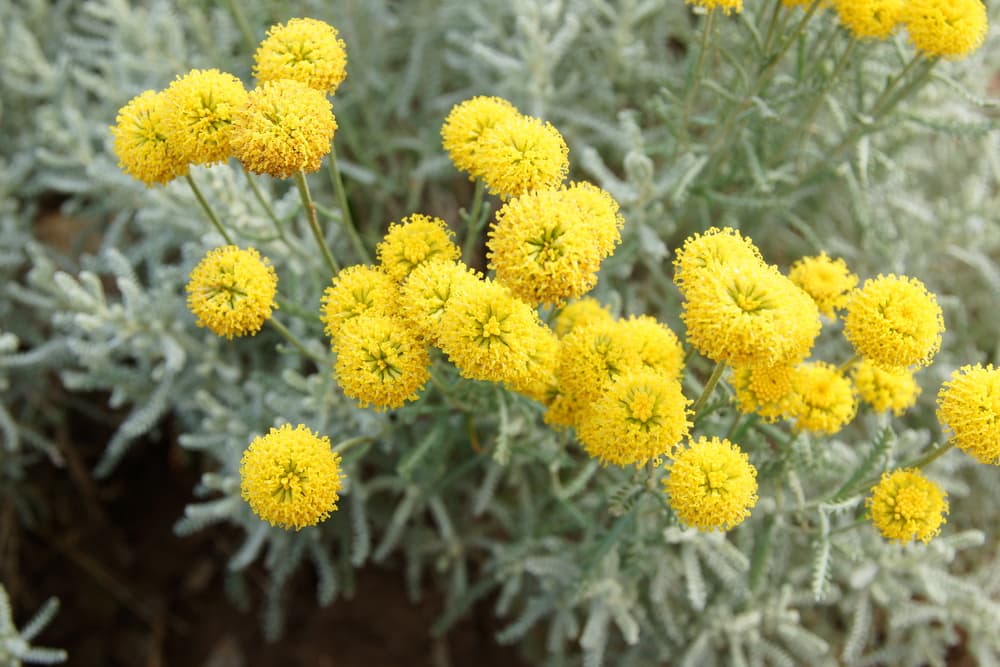
- RECOMMENDED VARIETY: ‘Pretty Carol’
- HARDINESS RATING: H5
- FOLIAGE TYPE: EVERGREEN
- FOLIAGE SEASONS: YEAR-ROUND
Although it’s commonly known as cotton lavender, Santolina chamaecyparissus doesn’t wear the distinctive lilac garb that is synonymous with its family.
Instead, this cultivar boasts ostentatious yellow blossoms that take pom-pom form, which stand out like a sore thumb against the powdery grey background of its foliage.

It’s that contrast which sets S. chamaecyparissus apart from other garden shrubs, making it an ideal option for when a splash of bold colour is warranted.
The blooms aren’t just popular with green-fingered enthusiasts, either; they also bring bees and butterflies to your garden in their droves.
As such, it’s excellent as colourful ground cover, or as a gap-filler in spotty borders and beds.
It can also do equally well in containers and pots and, given its vulnerability during the colder months, this planting strategy might be preferable to protect it in winter.
11) Stachys byzantina
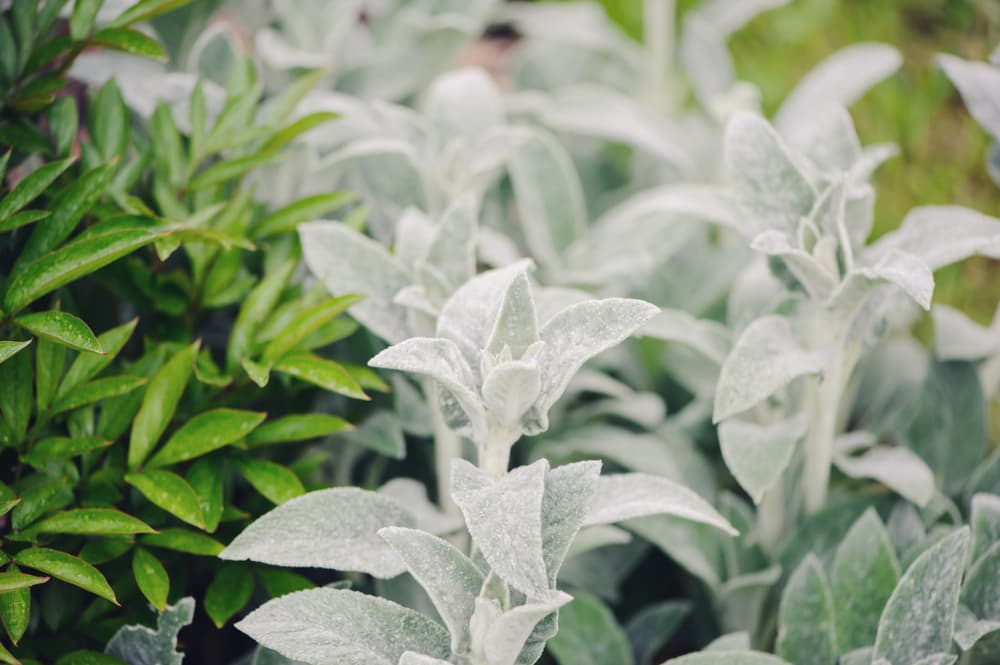
- RECOMMENDED VARIETY: ‘Silver Carpet’
- HARDINESS RATING: H7
- FOLIAGE TYPE: EVERGREEN
- FOLIAGE SEASONS: YEAR-ROUND
A hugely popular groundcover plant, Stachys byzantina is more recognisable by its common name, lamb’s ears.
It has earned the moniker due to the fuzzy, oval-shaped leaves which offer year-round interest through their woollen consistency and cosmetic appeal.
The ‘Silver Carpet’ variety pictured above is one of the few Stachys examples which rarely flowers, but this doesn’t mean it’s not a hit with pollinators and people alike.

Indeed, it’s the woolliness of its foliage which attracts one particular bee more than others, which collects the fine fibres on the surface of the leaves to line its nest.
Its evergreen nature, accompanied by its lack of blooms and its interesting texture, mean that ‘Silver Carpet’ is a favourite among those looking to bring mat-forming intrigue to the front of beds and borders.
It’s also relatively hardy, so it requires little in the way of upkeep once established, as long as it’s provided with enough sunshine.
References
- 1Helichrysum petiolare (strawflower). (2022). CABI Compendium. https://doi.org/10.1079/cabicompendium.114715

